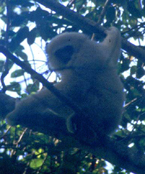|
 The Lar Gibbon is found in Indonesia, Laos, Malaysia, Myanmar
and Thailand, although their range historically extended from southwest
China to Thailand and Burma south to the whole Malay Peninsula and
Sumatra. They are usually found in dipterocarp forest, including
primary lowland and submontane rainforest, mixed deciduous bamboo
forest, and seasonal evergreen forest. They are mostly frugivorous
with fruit constituting fifty percent of their diet, but leaves,
insects and flowers form the remainder. Their fur varies from black
and dark-brown to light-brown, sandy colors. The hands and feet
are white-colored, likewise a ring of white hair surrounds the black
face. They are usually active for an average of eight hours per
day, leaving their sleeping sites right around sunrise and entering
sleeping trees an average of three hours before sunset. They spend
their days feeding, resting, traveling, in social activities, vocalizing,
and in intergroup encounters. True brachiators, they propel themselves
through the forest by swinging under the branches using their arms.
With their hooked hands, they can move swiftly with great momentum,
swinging from the branches. Although they rarely come to the ground
naturally, while there, they walk bipedally with arms raised above
their heads for balance. Their social organization is dominated
by monogamous family pairs, with one breeding male and one female
along with their offspring. Family groups inhabit a firm territory,
and each morning, the family gathers on the edge of its territory
and begins a "great call", a duet between the breeding pair. Each
species has a typified call and each breeding pair has unique variations
on that theme. Recent studies indicate that gibbon song have evolved
to communicate conflict in terms of predation. In the presence of
Asiatic tiger, clouded leopard, crested serpent eagle and reticulated
python songs were more likely to contain sharp wow elements than
normal duets. Sexually, they are similar to other gibbons. Mating
occurs in every month of the year, but most conceptions occur during
the dry season in March, with a peak in births during the late rainy
season, in October. On average, females reproduce for the first
time at about eleven years of age. Gestation is six months long
on average, and pregnancies are usually of a single young. Young
are nursed for approximately two years, and full maturity comes
at about eight years. On average they live to be twenty-five years
old. They are threatened in various ways: they are sometimes hunted
for their meat, sometimes a parent is killed to capture young animals
for pets, but perhaps the most pervasive is the loss of habitat.
Their habitats are threatened by forest clearance for the construction
of roads, agriculture, ecotourism, domesticated cattle and elephants,
forest fires, subsistence logging, illegal logging, new village
settlement, and palm oil plantations.
The Lar Gibbon is found in Indonesia, Laos, Malaysia, Myanmar
and Thailand, although their range historically extended from southwest
China to Thailand and Burma south to the whole Malay Peninsula and
Sumatra. They are usually found in dipterocarp forest, including
primary lowland and submontane rainforest, mixed deciduous bamboo
forest, and seasonal evergreen forest. They are mostly frugivorous
with fruit constituting fifty percent of their diet, but leaves,
insects and flowers form the remainder. Their fur varies from black
and dark-brown to light-brown, sandy colors. The hands and feet
are white-colored, likewise a ring of white hair surrounds the black
face. They are usually active for an average of eight hours per
day, leaving their sleeping sites right around sunrise and entering
sleeping trees an average of three hours before sunset. They spend
their days feeding, resting, traveling, in social activities, vocalizing,
and in intergroup encounters. True brachiators, they propel themselves
through the forest by swinging under the branches using their arms.
With their hooked hands, they can move swiftly with great momentum,
swinging from the branches. Although they rarely come to the ground
naturally, while there, they walk bipedally with arms raised above
their heads for balance. Their social organization is dominated
by monogamous family pairs, with one breeding male and one female
along with their offspring. Family groups inhabit a firm territory,
and each morning, the family gathers on the edge of its territory
and begins a "great call", a duet between the breeding pair. Each
species has a typified call and each breeding pair has unique variations
on that theme. Recent studies indicate that gibbon song have evolved
to communicate conflict in terms of predation. In the presence of
Asiatic tiger, clouded leopard, crested serpent eagle and reticulated
python songs were more likely to contain sharp wow elements than
normal duets. Sexually, they are similar to other gibbons. Mating
occurs in every month of the year, but most conceptions occur during
the dry season in March, with a peak in births during the late rainy
season, in October. On average, females reproduce for the first
time at about eleven years of age. Gestation is six months long
on average, and pregnancies are usually of a single young. Young
are nursed for approximately two years, and full maturity comes
at about eight years. On average they live to be twenty-five years
old. They are threatened in various ways: they are sometimes hunted
for their meat, sometimes a parent is killed to capture young animals
for pets, but perhaps the most pervasive is the loss of habitat.
Their habitats are threatened by forest clearance for the construction
of roads, agriculture, ecotourism, domesticated cattle and elephants,
forest fires, subsistence logging, illegal logging, new village
settlement, and palm oil plantations.
|
 The
Lar Gibbon - Issue
Thirty-Seven
The
Lar Gibbon - Issue
Thirty-Seven